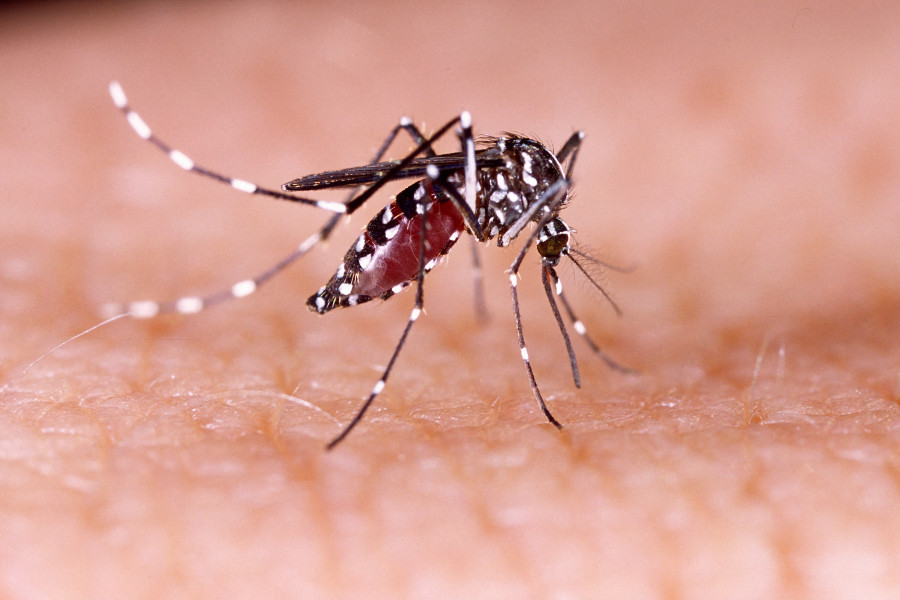Health
Diseases climb up mountains as climate warms
As kala-azar and dengue among others make it to mountain districts, experts call for immediate mitigation measures.
Arjun Poudel
Of the 219 total cases of kala-azar reported in the fiscal year 2020-2021, around 21 were reported from Kalikot, a mountain district. Kala-azar, also known as visceral leishmaniasis or black fever, is transmitted through the bite of an infected female phlebotomine sandfly, which in the past would not survive in areas above 650 metres. Detection of kala-azar cases in unfamiliar places like Kalikot, where the elevation ranges from 738 metres to above 4,000 metres, indicates that phlebotomine sandflies are moving up mountains because the earth is warming.
According to the Epidemiology and Disease Control Division, cases of vector-borne diseases such as kala-azar and dengue have been reported from districts like Mugu, Humla, Jajarkot, Jumla and Salyan, which are considered colder places.
A recent report of the United Nations “Climate Change 2022: Impacts, Adaptation and Vulnerability” states that at least six major vector-borne diseases affected by the climate drivers have recently emerged in Nepal and are now considered endemic, with climate change implicated as the primary driver.
The report also shows increasing evidence that climate warming has extended the elevational distribution of Anopheles, Culex and Aedes mosquito vectors above 2,000 metres in Nepal. Of about 460 species of Anopheles, over 100 transmit malaria. Over 950 species of Aedes spread dengue, chikungunya, Zika, yellow fever and West Nile virus. Over 1,000 species of Culex transmit Japanese encephalitis, filariasis and West Nile virus.
“Host animals in novel areas may be immunologically naive, therefore more vulnerable to severe illness,” the report states.
Vector-borne diseases or VBDs are spread by carriers like mosquitoes, sandflies, kissing bugs and ticks. The report says that viruses like dengue, chikungunya and Japanese encephalitis are emerging in Nepal in hilly and mountainous areas.
“The emergence of VBDs in the areas which were considered non-endemic in the past can pose a major public health challenge for Nepal,” said Dr Gokarna Dahal, chief of the Vector Control Section at the Epidemiology and Disease Control Division.
In 2019, at least six people died and over 16,000 were hospitalised due to the dengue virus that had spread to 68 of the country’s 77 districts. Even Kathmandu Valley witnessed a dengue outbreak in 2021, sickening hundreds of people.
The Epidemiology and Disease Control Division said that cases of other vector-borne diseases—dengue, scrub typhus and malaria—have been reported in many districts throughout the country including Jajarkot, Rukum West, Salyan, Bajura, Baitadi and Bajhang, all high-altitude areas.
Lymphatic filariasis (also known as elephantiasis), a mosquito-borne parasitic disease caused by filarial worms transmitted by mosquitoes, has been reported in Rasuwa, an unfamiliar place for the vector in the past.
Experts say frequent movements of the people is also one of the reasons for diseases being detected in novel areas. When vectors of diseases bite an infected person, they transmit the disease and the vectors’ entire generation gets infected.
Public health experts as well as climate scientists say though climate change induced impacts in Nepal’s health care sectors have been visible in recent years, no concrete mitigation measures have been adopted.
“We have been drawing the attention of the authorities concerned to new challenges posed by climate change,” said Dr Meghnath Dhimal, chief researcher at Nepal Health Research Council, whose PhD research is cited by the UN’s climate report. “Impacts of climate change have been visible in many sectors including health. We have been calling on authorities to immediately introduce mitigation measures for a long time.”
According to Dhimal, training and orientation for health care providers, strengthening of public health systems, setting up of laboratories, and timely diagnosis and treatment are some of the ways to deal with the emerging challenges.
Despite Nepal facing challenges from VBDs in high-altitude areas, the government has continued to focus its programmes mainly in the Tarai region where incidence of such cases were high in the past.
The UN report says that climate change further increases infection risk by altering pathogens and this can lead to novel disease emergence in new places, more frequent and larger outbreaks, and longer or shifted seasons of transmission.
VBDs in novel and high-altitude areas could also pose a serious challenge to Nepal’s various health targets.
The government in 2003 launched a mass drug administration programme against lymphatic filariasis in 2003, aiming to eliminate the disease by 2020. Five rounds of mass drug administration programmes were supposed to control the disease. Despite continued campaigns for 12 years, the disease has not come under control in some districts. After failing to achieve the target, the Health Ministry first extended the deadline to 2028 and now it has been extended to 2030.
Nepal had also committed to eliminating kala-azar by 2024 but officials said that it is impossible to meet the target.
The government has set 2022 as the target year to make zero indigenious case and witness zero malaria case in 2023, 2024 and 2025 and celebrate its elimination in 2026.
Officials, however, are sceptical about the success, due to the growing number of cases every year and cases of disease being reported in unfamiliar places. Experts say there are no mitigation programmes in the areas from where such diseases are being reported.
Though experts have been calling for disease surveillance and research for mitigation of risk and large-scale outbreaks—like the dengue outbreak in 2019—no study of vectors has been carried out since the start of the Covid-19 pandemic.
“Ever since the Covid-19 struck the country, we have not carried out vector surveys in the last two years,” said Sishir Panta, an entomologist at Vector Borne Disease Research and Training Centre in Hetauda. “Studies should be carried out regularly to ascertain the presence and density of vectors so that we can make policies and control strategies accordingly.”
The World Health Organisation says vector-borne diseases account for more than 17 percent of all infectious diseases, causing more than 700,000 deaths annually throughout the world.
Scientists say the whole world has been struggling to fight climate change and global warming. A country like Nepal, which can do bare minimum in the fight, can at least work towards mitigating risks by taking measures suggested by experts, according to them.
Effective surveillance of diseases, strengthening health care systems, providing training to health care workers, and encouraging people for behavioural change are some of the measures authorities could adopt to lessen the risks and their impacts.
“Early detection can help in controlling the vectors and treating the infected on time. This way we can avoid large scale disease outbreaks in communities,” said Dr Indira Kandel, senior divisional meteorologist at Climate Analysis Section under the Department of Hydrology and Meteorology. “We have to lessen the impacts of the climate phenomena by applying adaptation strategies.”
Experts say not only countries like Nepal but developed nations are also encountering adverse impacts of climate change, witnessing imported cases of many infections. But these countries have been mitigating the impacts and preventing massive outbreak through timely response, according to them.
Dhimal, the chief researcher at the Nepal Health Research Council, says if authorities can put in place measures to timely detect the problems and treat them, massive outbreaks can be avoided.
“For a timely response, we need robust health care infrastructures and systems in place for investigation and research,” said Dhimal. “We also need to increase investments for study and research, which is key to making policies and taking mitigation measures.”




 20.2°C Kathmandu
20.2°C Kathmandu















